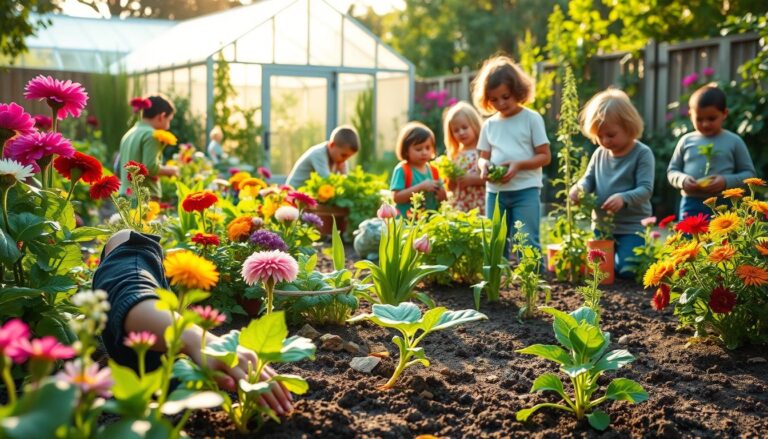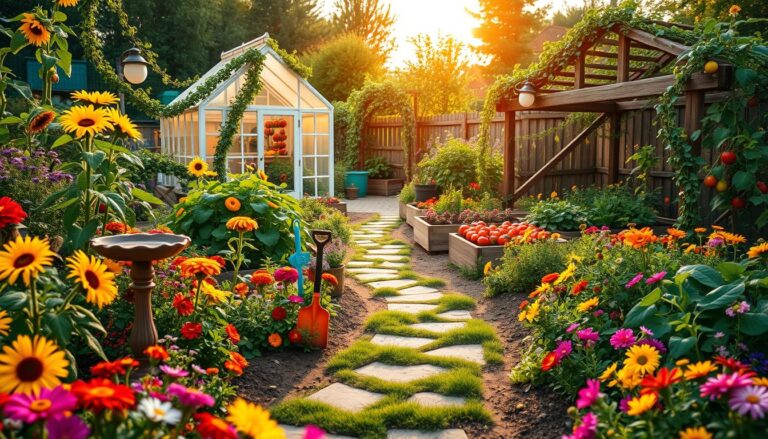Growing your own fruits and vegetables is rewarding but comes with challenges. One big issue is keeping pests away from your produce.
Good pest prevention is key for a healthy garden. Without it, pests can harm your crops, ruining your harvest.
With simple strategies, you can protect your garden and get a great harvest. This article will show you how to keep pests out of your home garden.
Understanding the Threat: Common Pests That Target Your Garden
Many pests, from tiny insects to larger animals, can harm your garden. It’s important to use organic pest control and natural pest management to protect it.
Insects vs. Disease: Knowing Your Enemy
Garden pests fall into two main groups: insects and diseases. Insects like aphids and beetles can damage plants directly. Diseases, caused by fungi and viruses, can weaken or kill them. Knowing the difference helps you choose the right pest control methods for gardens.
To fight insects, you can use organic methods like introducing beneficial insects or organic pesticides. For diseases, practices like crop rotation and sanitation are key to prevent their spread.
The Economic Impact of Pest Damage
Pest damage can hurt gardeners’ wallets, whether they grow for fun or profit. Losing crops to pests can lead to financial losses. It can even threaten food security. Effective pest management is crucial to protect your plants and investment.
Using natural pest management can save money and help the environment. It reduces the need for chemical pesticides.
Identifying Common Fruit and Vegetable Pests
To keep your garden safe, it’s key to know the pests that harm fruits and veggies. Knowing how to spot them is the first step in pest control for fruits and vegetables.
Aphids, Caterpillars, and Beetles
These pests are very common and can really hurt your garden. It’s important to know how to tell them apart and what damage they do.
Identification Features
- Aphids are small, soft insects that stick together on plants.
- Caterpillars are the young of butterflies and moths, found on leaves.
- Beetles have a hard shell and come in many shapes.
Damage Patterns
- Aphids harm plants by sucking their sap, making leaves curl.
- Caterpillars eat leaves, stems, and fruits, causing damage.
- Beetles can chew on leaves, stems, and roots, depending on the type.
Mites, Thrips, and Whiteflies
These tiny pests can be as harmful as bigger ones. Spotting them early is crucial to control them.
Early Detection Methods
- Check plants often for signs of mites, thrips, and whiteflies.
- Use a magnifying glass to see these small insects.
- Yellow sticky traps can help catch whiteflies.
Common Symptoms
- Mites cause spots or bronzing on leaves.
- Thrips leave silver streaks or distorted growth.
- Whiteflies make leaves yellow and plants grow poorly.
Larger Pests: Rodents and Birds
Larger pests like rodents and birds can also harm your garden. Using eco-friendly pest control can help reduce their damage.
To catch rodents, use humane traps. To keep birds away, use netting or visual barriers. Using integrated pest management can protect your garden from many pests.
Prevention: The First Line of Defense
Being proactive in pest control can greatly improve your garden’s health and yield. By taking preventive steps, you can lower the chance of pests and keep your garden balanced.
Garden Planning and Crop Rotation
Good garden planning and crop rotation are key to stopping pests. By moving your crops each season, you can stop pests from multiplying. This also helps your soil stay healthy and fertile.
Crop rotation is important. Make sure to not plant the same family of crops in the same spot every year. For example, tomatoes and peppers should not be next to each other.
Physical Barriers and Traps
Using physical barriers and traps can also prevent pest damage. Row covers keep flying insects away, and fine mesh stops smaller pests. Sticky traps help catch and track pests, so you can spot problems early.
Healthy Soil Practices
Keeping your soil healthy is crucial for natural pest management. Composting and mulching make the soil better, hold more water, and support good microbes. Healthy plants in strong soil fight off pests and diseases better.
By using these preventive methods, gardeners can cut down on chemical pesticides. Instead, they can use non-toxic pest control methods. These are better for the environment and our health.
Pest Control for Fruits and Vegetables: Organic Approaches
Organic pest control is good for the environment and your garden’s health. It keeps pests away from your fruits and veggies without using harmful chemicals. This way, your family and the planet stay safe.
Beneficial Insects: Nature’s Pest Control
Using beneficial insects is a top organic pest control method. These natural helpers can cut down pest numbers, keeping your garden balanced.
Ladybugs and Lacewings
Ladybugs and lacewings are great for gardeners. Ladybugs eat aphids, and lacewings go after aphids, whiteflies, and spider mites. Just plant a variety of flowers and herbs to attract them.
Predatory Mites and Wasps
Predatory mites and some wasps are also good against pests. Mites eat spider mites, and some wasps target caterpillars and other pests. Make your garden welcoming to these beneficial insects.
Homemade Organic Sprays and Solutions
Homemade sprays and solutions are also effective. Recipes with garlic, neem oil, and soap can keep pests away without harming the environment or beneficial insects.
- Garlic spray: Blend garlic cloves with water and a bit of soap, then strain and spray on plants.
- Neem oil solution: Mix neem oil with water as directed and spray on affected areas.
- Soap solution: Combine mild dish soap with water and spray directly on pests.
Companion Planting Strategies
Companion planting is another smart organic pest control method. Planting certain veggies, herbs, and flowers together can naturally keep pests away. For example, marigolds with tomatoes repel nematodes, and basil improves tomato flavor and keeps pests off.
Some good companion planting pairs include:
- Marigolds with tomatoes to deter nematodes.
- Basil with tomatoes to improve flavor and deter pests.
- Radish with cucumbers to repel cucumber beetles.
Eco-Friendly Pest Management Techniques
Eco-friendly pest control is good for the environment and your garden. It aims to harm fewer beneficial organisms and the ecosystem.
Neem Oil and Other Plant-Based Repellents
Neem oil comes from the neem tree seeds. It stops insects from reproducing and kills them. Garlic oil and hot pepper sprays also keep pests away without harming them.
Using neem oil effectively means mixing it with water as the label says. Spray it on plants. It’s safe for humans and pets when done right.
Diatomaceous Earth and Other Natural Barriers
Diatomaceous earth is a powder that dries out insects, killing them. It’s safe for pets and humans but needs to be reapplied after rain. Row covers and copper tape also keep pests away.
Manual Removal Techniques
Manual removal means taking pests off plants by hand. You can use traps or other methods. It’s simple and works well with other green methods.
Sticky traps catch flying bugs, and picking off bigger pests works too. Keep an eye on your plants to make manual removal effective.
Chemical Options: When and How to Use Them Safely
Knowing when and how to use chemical pest control safely is key for gardeners. It helps protect fruits and vegetables well.
Understanding Pesticide Labels and Safety
Pesticide labels have important info on safe use. This includes dosage, how to apply, and potential dangers. It’s crucial to read and follow these instructions to avoid risks to people, pets, and the environment.
The label also shows the pre-harvest interval (PHI). This is the time after the last pesticide use before you can harvest your crops.
Low-Toxicity Chemical Solutions
Not all chemical pest controls are the same. Some are less toxic to humans and beneficial insects but still work against pests.
For example, insecticidal soaps and horticultural oils are low-toxicity options. They are safe for use in gardens.
| Chemical Type | Toxicity Level | Target Pests |
|---|---|---|
| Insecticidal Soap | Low | Aphids, Whiteflies |
| Horticultural Oil | Low | Mites, Aphids |
| Pyrethrin | Moderate | Flies, Mosquitoes |
Application Timing and Methods
The timing and method of pesticide use greatly affect its safety and effectiveness. Apply pesticides during the cooler parts of the day to reduce evaporation and drift.
Choosing the right application method is also key. This depends on the pest type and the product’s instructions.
Integrated Pest Management for Home Gardens
Integrated Pest Management (IPM) is a way to manage pests in gardens. It uses physical, cultural, biological, and chemical controls. This makes it great for home gardeners.
IPM helps gardeners use fewer chemical pesticides. This makes gardening safer and more sustainable. It’s about understanding the garden ecosystem and making smart choices.
The Five Steps of IPM
IPM has five main steps: identification, monitoring, setting thresholds, choosing controls, and evaluating them. Identification is key. It helps gardeners pick the best control methods.
- Identify the pest and understand its life cycle.
- Monitor the pest population regularly.
- Set threshold levels for the pest population.
- Choose appropriate control methods based on the pest and its impact.
- Evaluate the effectiveness of the control methods.
Monitoring and Threshold Levels
Monitoring means checking the garden for pests or damage often. It’s important to know when to act. Setting threshold levels helps decide when to control pests. This prevents over-controlling.
| Pest Monitoring Frequency | Action Threshold | Control Method |
|---|---|---|
| Weekly during peak season | Visible damage or pest presence | Organic sprays or traps |
| Bi-weekly during off-peak season | Significant pest population increase | Biological controls or cultural practices |
Record Keeping and Evaluation
Keeping records of pest sightings and control methods is crucial. It helps evaluate IPM success and make future adjustments.
IPM helps protect garden produce and the environment. It’s a flexible approach that requires learning and adjusting. But, it’s very beneficial for gardeners.
Seasonal Pest Control Strategies
Changing your pest control methods with the seasons is crucial for a successful garden. Different pests attack your garden at different times. Knowing these patterns is key to keeping pests away from your fruits and vegetables.
Spring Preparation and Early Season Protection
Spring is a time when pests can quickly damage your garden. Check your plants often for signs of pests. Use physical barriers like row covers to keep pests away from young plants.
Also, introduce beneficial insects that eat common pests. This is a natural way to manage pests.
Summer Vigilance: Peak Pest Season
Summer is when pests are most active. Keep a close eye on your garden and be ready to act. Use organic sprays like neem oil to keep pests away.
Also, keep your garden clean. Remove any debris or weeds that pests might hide in.
Fall and Winter Management for Next Season
In the fall, clean up your garden for the next year. Remove weeds that pests might hide in. Use companion planting to naturally keep pests away.
By doing these things, you can make your garden healthier for next year. This way, you can enjoy a full harvest.
By using these seasonal pest control strategies, you can keep pests away all year. This ensures a good harvest for you.
Conclusion: Creating a Sustainable Pest Management Plan
Effective pest control for home gardens needs a holistic approach. This includes using different methods to manage pests in a sustainable way. By knowing the common pests in your garden and understanding the threats, you can make a detailed plan to protect your crops.
Using eco-friendly pest control methods is key. This includes introducing beneficial insects and making homemade organic sprays. These methods help reduce the need for chemical pesticides. Also, using IPM strategies like crop rotation, physical barriers, and manual removal is important for a balanced ecosystem.
Adopting a sustainable pest management plan helps gardeners reduce environmental impact. It also ensures a healthy and productive harvest. Keeping track of pests, recording your efforts, and evaluating results are crucial for IPM success. By following these steps, you can have a strong and thriving garden that’s good for you and the environment.
FAQ
What are some effective organic pest control methods for fruits and vegetables?
How can I identify common pests in my garden?
What is Integrated Pest Management (IPM) and how can it be applied to home gardens?
Are chemical pesticides safe to use on fruits and vegetables?
How can I prevent pest damage in my garden through garden planning?
What are some eco-friendly pest management techniques I can use?
How does companion planting help with pest control?
What are the benefits of using beneficial insects for pest control?
How can I manage pests during peak summer months?

Sortemdia nasceu com o propósito de trazer alegria e oportunidades para todos por meio de sorteios gratuitos de prêmios incríveis. O site tem como missão oferecer experiências acessíveis, divertidas e justas para quem deseja concorrer a produtos, serviços e brindes sem pagar nada por isso. Acreditamos que a sorte pode bater à porta de qualquer pessoa — e no Sortemdia, ela pode chegar com apenas um clique.



